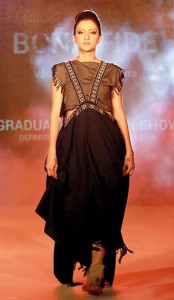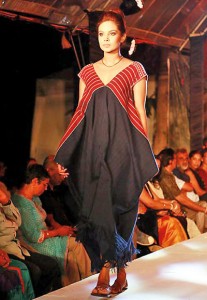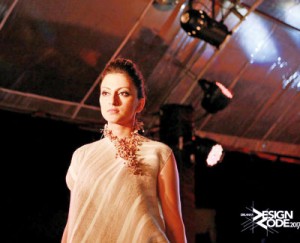Arts
Explosion of intellect and innovation
View(s):From banana yarn to handloom creations the students of the Department of Integrated Design (DID), University of Moratuwa presented carefully conceptualised collections at the grand finale of Design Code 2017
By Tarini Pilapitiya
‘A garment isn’t just a material or piece of cloth that is put on to spaces of a human body -it is instead an advanced concept which has gone beyond the factors of design’. This was a premise that guided students of the Department of Integrated Design (DID), University of Moratuwa when they presented their collections at the grand finale of Design Code 2017 at Trace- Expert City on May 21.

Using the Dumbara weave: Vatsala Gunasekera (left also)
The show opened with unique collections that sashayed down the ramp — the outcome of a carefully thought-out process where students were encouraged to look beyond the superficiality of fashion. The range of collections went from ‘Avant Garde’ to ‘Ready-to-Wear’.
With the growing trend of ethical and eco-friendly wearables in the industry the young designers were encouraged to design within these guidelines as part of their final projects. Their take on it was refreshing. Poorni Wijesinghe’s collection was done entirely in banana yarn. With no added chemicals and no cutting or sewing of individual garments (the garments were woven in the loom itself) this young designer managed to wow audiences with her dexterity in design, using the traditional craft method and minimizing wastage, to ultimately create a chic, sophisticated selection that stunningly complimented Sri Lankan skin tones and silhouettes.
The evening also included innovative designs from Colombo Fashion Week (CFW) 2016 Best Emerging Fashion Designer Anushika Perera, also an undergraduate of the programme, who designed a collection using hand loom craftsmanship –a denim effect with the use of the hand loom. Vatsala Gunasekara, a fellow undergraduate, also incorporated traditional craftsmanship and minimum wastage through the use of the Dumbara Weave.
The DID is justly identified as a pioneer in the specialization of design higher education in our country. For over a decade the Department of Integrated Design (DID) has created its own identity by developing the field of design as a four year full time honours degree; The Bachelor of Design. Taking on the demand in the country for diversification in higher education qualifications, the DID has opened new avenues for students.
A spiring to enrich the Sri Lankan design industry the course attempts to cultivate designers with a sense of individuality through the “mingling of creativity and functionality”. Offering specialization in Media and Communication Design, Fashion and Lifestyle Design and Product Design, the course provides many avenues of growth.
“Sri Lanka Design Code” aims to highlight the importance of cultivating new talent whilst aspiring to conserve, educate and regenerate new design knowledge. The event included the graduation exhibition, culture code, design seminars and workshops and a Department- Industry Consultative Board Meeting.
Head of the Department, Architect Sithumini Rathnamalala commented “Our aim is not to create mere ‘designers’ but a set of context-sensitive leaders in creative problem-solving for the country”. Senior Lecturer, and the first Department Head of the DID, Archt. Prasanna Pitigala Liyanage said that through their courses they are hoping to stimulate the intelligence of the students so that they are able to take on any challenge in the future. “Our aim is to develop the students’ innovative and emotional intelligence.”

Handloom with a denim effect: A creation by Anushika Perera
The faculty of the DID is not interested in following the mundane routines of teaching instead projecting themselves as life coaches of sorts, interested and invested in moulding individual personalities. Added Mr.Liyanage, “Here we are not teaching we are merely coaching.”
Preparing for the exhibition students were encouraged to analyse their own mistakes and designs, evaluating how they themselves could better their work. This year students were encouraged to work alongside traditional Sri Lankan craftsmen, living with them to understand their art and, re-entering the university gates fresh with new knowledge of the skills that go into the craftsman’s work.
May 20 and 21 were a flurry of activity for the aspiring designers and industry alums. The Graduation Exhibition saw four students from each of the four fields of specialization; Media and Communication Design, Fashion and Lifestyle Design and Product Design take centre stage displaying their final year’s hands- on work. Design Code 2017’s side event titled ‘Culture Code’ showcased the talents of Level 2 students where they explore design possibilities and come up with innovative solutions for the traditional craft industries of Sri Lanka.
Begun in 2012 the project has looked at traditional crafts ranging from cane, una (bamboo), tala (talipot), coconut shell and ramba (banana fibre). Facilitating relationships between emerging creatives and traditionally skilled artisans, this saw a skill fusion between the two that made the two-day event an innovative take on the design industry. Going one step further, Design Code also hosted seminars and workshops between experts of the industry and emerging student designers to help build more knowledge for the amateur designers.

Poorni Wijesinghe’s creations made of banana yarn. (see right also). Pix courtesy Design Code 2017
With around 150 students taking part, Design Code was an explosion of intellect and innovation. A feature of the exhibition was, we believe, the innovative designing and the transparency of the processes. The students were able to take home many lessons and the audience too were enriched with new found understanding and knowledge, awareness and respect for the design industry as a lucrative trade.
Prasanna Liyanage commented that students are evolving and we are also learning from them. “Every year we see an evolution among our students and we couldn’t be more proud.”

